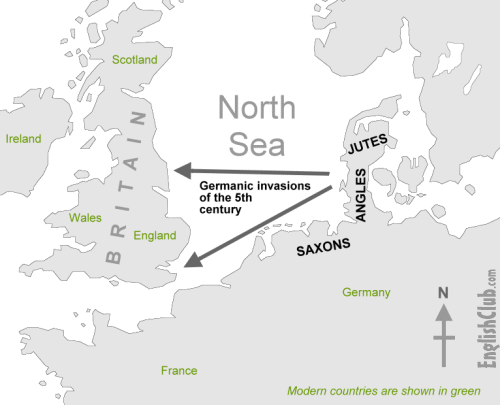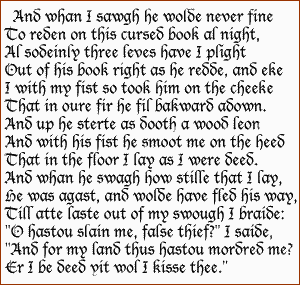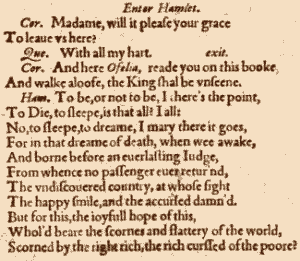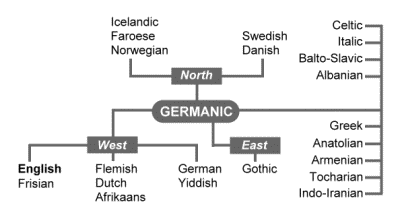WATCH LIVE CRICKET
Monday, August 25, 2014
Sunday, August 24, 2014
History of the English Language
The history of the English language really started with the arrival of three Germanic tribes who invaded Britain during the 5th century AD. These tribes, the Angles, the Saxons and the Jutes, crossed the North Sea from what today is Denmark and northern Germany. At that time the inhabitants of Britain spoke a Celtic language. But most of the Celtic speakers were pushed west and north by the invaders - mainly into what is now Wales, Scotland and Ireland. The Angles came from "Englaland" [sic] and their language was called "Englisc" - from which the words "England" and "English" are derived.

Germanic invaders entered Britain on the east and south coasts in the 5th century
Old English (450-1100 AD)
 Part of Beowulf, a poem written in Old English |
Middle English (1100-1500)
 An example of Middle English by Chaucer |
Modern English
Early Modern English (1500-1800)
Towards the end of Middle English, a sudden and distinct change in pronunciation (the Great Vowel Shift) started, with vowels being pronounced shorter and shorter. From the 16th century the British had contact with many peoples from around the world.

Hamlet's famous "To be, or not to be" lines, written in Early Modern English by Shakespeare
|
This, and the Renaissance of Classical learning, meant that many new words and phrases entered the language. The invention of printing also meant that there was now a common language in print. Books became cheaper and more people learned to read. Printing also brought standardization to English. Spelling and grammar became fixed, and the dialect of London, where most publishing houses were, became the standard. In 1604 the first English dictionary was published.
Late Modern English (1800-Present)
The main difference between Early Modern English and Late Modern English is vocabulary. Late Modern English has many more words, arising from two principal factors: firstly, the Industrial Revolution and technology created a need for new words; secondly, the British Empire at its height covered one quarter of the earth's surface, and the English language adopted foreign words from many countries.
Varieties of English
From around 1600, the English colonization of North America resulted in the creation of a distinct American variety of English. Some English pronunciations and words "froze" when they reached America. In some ways, American English is more like the English of Shakespeare than modern British English is. Some expressions that the British call "Americanisms" are in fact original British expressions that were preserved in the colonies while lost for a time in Britain (for example trash for rubbish, loan as a verb instead of lend, and fall for autumn; another example, frame-up, was re-imported into Britain through Hollywood gangster movies). Spanish also had an influence on American English (and subsequently British English), with words like canyon, ranch, stampede and vigilante being examples of Spanish words that entered English through the settlement of the American West. French words (through Louisiana) and West African words (through the slave trade) also influenced American English (and so, to an extent, British English).
Today, American English is particularly influential, due to the USA's dominance of cinema, television, popular music, trade and technology (including the Internet). But there are many other varieties of English around the world, including for example Australian English, New Zealand English, Canadian English, South African English, Indian English and Caribbean English.
The Germanic Family of Languages

English is a member of the Germanic family of languages. Germanic is a branch of the Indo-European language family.

English is a member of the Germanic family of languages. Germanic is a branch of the Indo-European language family.
| A brief chronology of English | ||
|---|---|---|
| 55 BC | Roman invasion of Britain by Julius Caesar | Local inhabitants speak Celtish |
| AD 43 | Roman invasion and occupation. Beginning of Roman rule of Britain | |
| 436 | Roman withdrawal from Britain complete | |
| 449 | Settlement of Britain by Germanic invaders begins | |
| 450-480 | Earliest known Old English inscriptions | Old English |
| 1066 | William the Conqueror, Duke of Normandy, invades and conquers England | |
| c1150 | Earliest surviving manuscripts in Middle English | Middle English |
| 1348 | English replaces Latin as the language of instruction in most schools | |
| 1362 | English replaces French as the language of law. English is used in Parliament for the first time | |
| c1388 | Chaucer starts writing The Canterbury Tales | |
| c1400 | The Great Vowel Shift begins | |
| 1476 | William Caxton establishes the first English printing press | Early Modern English |
| 1564 | Shakespeare is born | |
| 1604 | Table Alphabeticall, the first English dictionary, is published | |
| 1607 | The first permanent English settlement in the New World (Jamestown) is established | |
| 1616 | Shakespeare dies | |
| 1623 | Shakespeare's First Folio is published | |
| 1702 | The first daily English-language newspaper, The Daily Courant, is published in London | |
| 1755 | Samuel Johnson publishes his English dictionary | |
| 1776 | Thomas Jefferson writes the American Declaration of Independence | |
| 1782 | Britain abandons its colonies in what is later to become the USA | |
| 1828 | Webster publishes his American English dictionary | Late Modern English |
| 1922 | The British Broadcasting Corporation is founded | |
| 1928 | The Oxford English Dictionary is published | |
History of Mathematics
Mathematics is the science of numbers and there are several different branches of mathematical science including algebra, geometry, and calculus. The Merriam-Webster dictionary defines mathematics as the science of numbers and their operations, interrelations, combinations, generalizations, and abstractions and of space configurations and their structure, measurement, transformations, and generalizations.
Mathematics is not an invention. Discoveries and laws of science are not considered inventions. Inventions are material things and processes. However, there is a history of mathematics, a relationship between mathematics and inventions, and mathematical instruments are considered inventions.
According to Mathematical Thought from Ancient to Modern Times, mathematics as an organized science did not exist before the classical Greeks of the period from 600 to 300 BC entered upon the scene. There were, however, prior civilizations in which the beginnings or rudiments of mathematics were created.
When civilization began to trade, a need to count was created. When humans traded goods, they needed a way to count the goods and to calculate the cost of those goods. The very first device for counting numbers was the human hand, counting on fingers. To count beyond ten fingers, mankind used natural markers, rocks or shells. From that point, counting boards and the abacuswere invented.
Abacus
One of the first tools for counting invented, the abacus was invented around 1200 A.D. in China.
Accounting
The innovative Italians of the Renaissance (fourteenth through sixteenth century) are widely acknowledged to be the fathers of modern accounting .
Algebra
The first treatise on algebra was written by Diophantus of Alexandria in the 3rd century AD. Algebra comes from the Arabic word al-jabr an ancient medical term meaning "the reunion of broken parts.''
Archimedes
Archimedes was a mathematician and inventor from ancient Greece, best known for his discovery of the relation between the surface and volume of a sphere and its circumscribing cyclinder, for his formulation of a hydrostatic principle (Archimedes' principle) and for inventing the Archimedes screw (a device for raising water).
Differential
Gottfried Wilhelm Leibniz (b. 1646, d. 1716) was a German philosopher, mathematician, and logician who is probably most well known for having invented the differential and integral calculus (independently of Sir Isaac Newton).
Graph
A graph is a pictorial representation of statistical data or of a functional relationship between variables. William Playfair (1759-1823) is generally viewed as the inventor of most of graphical forms used to display data, including: line plots, bar chart, and pie chart.
Logarithms and the Decimal Point
John Napier was the Scottish mathematician who invented logarithms and the decimal point.
Pythagoreanism
Pythagoreanism is a school of philosophy school and a religious brotherhood, believed to have been founded by Pythagoras of Samos, who settled in Croton in southern Italy about 525 BC. The group had a profound effect on the development of mathematics.
Protractor
An instrument used to construct and measure plane angles. The simple protractor looks like a semicircular disk marked with degrees, from 0º to180º. The simple protractor is an ancient device. The first complex protractor was created for plotting the position of a boat on navigational charts. Called a three-arm protractor or station pointer, it was invented in 1801, by Joseph Huddart, a U.S. naval captain. The centre arm is fixed, while the outer two are rotatable, capable of being set at any angle relative to the centre one.
Slide Rulers
Circular and rectangular slide rules, an instrument used for mathematical calculations were both invented by mathematician William Oughtred .
Zero
Zero was invented by the Hindu mathematicians Aryabhata and Varamihara in India around or shortly after the year 520 A.D.
Math Symbol
In 1557, the = sign first used by Robert Record. In 1631, >,
It should be noted that the brief descriptions given are just that "brief." Their purpose is to hopefully instill a little curiosity and encourage the reader to seek out further knowledge on these people and topics.
50,000 B.C.E.
|
Evidence of counting
|
50,000 B.C.E.
|
Neanderthal man
| ||
25,000 B.C.E.
|
Primitive geometrical designs
|
25,000 B.C.E.
|
Paleolithic art: Cro-Magnon man
| ||
4000 B.C.E.
|
Use of metals
| ||||
3500 B.C.E.
|
Writing
| ||||
3000 B.C.E.
|
3000 B.C.E.
| ||||
2773 B.C.E.
|
Likely introduction of the Egyptian calendar
(Some hypothesize 4241 B.C.E. as the origin.) | ||||
2500 B.C.E.
| |||||
2400 B.C.E.
|
2400 B.C.E.
|
Sumerian-Akkadian Empire
| |||
1850 B.C.E.
| |||||
1800 B.C.E.
|
Code of Hammurabi
| ||||
1700 B.C.E.
|
Stonehenge in England
| ||||
1650 B.C.E.
| |||||
1400 B.C.E.
| |||||
1350 B.C.E.
|
Use of iron: sundials: water clocks
| ||||
1200 B.C.E.
|
Trojan war
| ||||
776 B.C.E.
|
First Olympiad
| ||||
753 B.C.E.
| |||||
740 B.C.E.
|
Works of Homer and Hesoid
| ||||
586 B.C.E.
|
Babylonia captivity
| ||||
585 B.C.E.
| |||||
518 B.C.E.
| |||||
538 B.C.E.
| |||||
480 B.C.E.
|
Battle of Thermopylae
| ||||
461 B.C.E.
|
Beginning of the Age of Pericles
| ||||
450 B.C.E.
| |||||
430 B.C.E.
|
430 B.C.E.
| ||||
429 B.C.E.
| |||||
427 B.C.E.
|
Birth of Plato
| ||||
420 B.C.E.
| |||||
404 B.C.E.
| |||||
399 B.C.E.
| |||||
360 B.C.E.
| |||||
350 B.C.E.
| |||||
332 B.C.E.
| |||||
323 B.C.E.
| |||||
322 B.C.E.
|
Death of Aristotle
| ||||
305 B.C.E.
| |||||
300 B.C.E.
| |||||
280 B.C.E.
| |||||
264 B.C.E.
|
First Punic War
| ||||
260 B.C.E.
| |||||
230 B.C.E.
| |||||
225 B.C.E.
| |||||
212 B.C.E.
| |||||
210 B.C.E.
| |||||
150 B.C.E.
| |||||
146 B.C.E.
|
Destruction of Carthage
| ||||
140 B.C.E.
| |||||
75 B.C.E.
|
.
| ||||
44 B.C.E.
|
Death of Julius Caesar
| ||||
60 C.E.
| |||||
75 C.E.
|
Works of Heron of Alexandria
| ||||
100 C.E.
|
Menelaus' Spherica
| ||||
122 C.E.
| |||||
150 C.E.
| |||||
180 C.E.
|
Death of Marcus Aurelius
| ||||
250 C.E.
| |||||
320 C.E.
|
Pappus' Mathematical Collections
| ||||
324 C.E.
|
Founding of Constantinople
| ||||
405 C.E.
| |||||
415 C.E.
| |||||
455 C.E.
|
Vandals sack Rome
| ||||
476 C.E.
|
Traditional “fall” of Rome
| ||||
524 C.E.
| |||||
529 C.E.
| |||||
530 C.E.
| |||||
641 C.E.
| |||||
732 C.E.
| |||||
775 C.E.
| |||||
814 C.E.
| |||||
830 C.E.
| |||||
999 C.E.
|
Gebert becomes Pope Sylvester II
| ||||
1066 C.E.
| |||||
1096 C.E.
|
First Crusade
| ||||
1114 C.E.
| |||||
1142 C.E.
| |||||
1170 C.E.
| |||||
1202 C.E.
| |||||
1204 C.E.
|
Crusaders sack Constantinople
| ||||
1215 C.E.
|
Magna Carta
| ||||
1270 C.E.
| |||||
1271 C.E.
|
Travels of Marco Polo:
mechanical clocks (approx.) | ||||
1286 C.E.
|
Invention of eyeglasses (approx.)
| ||||
1303 C.E.
| |||||
1348 C.E.
| |||||
1364 C.E.
|
Death of Petrarch
| ||||
1431 C.E.
|
Joan of Arc burned
| ||||
1440 C.E.
| |||||
1453 C.E.
|
Fall of Constantinople
| ||||
1464 C.E.
| |||||
1482 C.E.
| |||||
1483 C.E.
|
Murder of the princes in the Tower
| ||||
1485 C.E.
|
Henry VII, the first Tutor
| ||||
1489 C.E.
| |||||
1492 C.E.
|
1492 C.E.
|
Columbus discovers the Americas
| |||
1517 C.E.
|
Protestant Reformation
| ||||
1520 C.E.
|
Field of the Cloth of Gold
| ||||
1527 C.E.
| |||||
1534 C.E.
| |||||
1543 C.E.
| |||||
1544 C.E.
| |||||
1545 C.E.
| |||||
1553 C.E.
| |||||
1558 C.E.
|
Accession of Elizabeth I in England
| ||||
1564 C.E.
|
Birth of Galileo
|
1564 C.E.
|
Birth of Shakespeare and death of Michelangelo
| ||
1572 C.E.
|
1572 C.E.
| ||||
1579 C.E.
| |||||
1584 C.E.
|
Assassination of William of Orange
| ||||
1588 C.E.
|
Drake's defeat of the Spanish armada
| ||||
1595 C.E.
| |||||
1598 C.E.
| |||||
1603 C.E.
|
Death of Elizabeth I
| ||||
1609 C.E.
|
Kepler's Astronomia nova :
Galileo's telescope | ||||
1614 C.E.
| |||||
1616 C.E.
|
Deaths of Shakespeare and Cervantes
| ||||
1620 C.E.
|
1620 C.E.
|
Landing of Pilgrims in America
| |||
1626 C.E.
|
Death of Francis Bacon
| ||||
1628 C.E.
|
Harvey's De motu cordis et sanguinis
| ||||
1629 C.E.
| |||||
1636 C.E.
|
Harvard College founded
| ||||
1637 C.E.
| |||||
1639 C.E.
| |||||
1640 C.E.
| |||||
1642 C.E.
| |||||
1643 C.E.
|
Assassination of Louis XIV
| ||||
1644 C.E.
|
Torricelli's Barometer
| ||||
1649 C.E.
|
Charles I beheaded
| ||||
1655 C.E.
|
Wallis publishes Arithmetica infinitorium
| ||||
1658 C.E.
|
Huygens' cyclodial pendulum clock
| ||||
1660 C.E.
|
The Restoration
| ||||
1662 C.E.
|
Royal Society founded
| ||||
1666 C.E.
|
Académie des Sciences founded
| ||||
1667 C.E.
| |||||
1668 C.E.
|
Mercator publishes Logarithmotechnia
| ||||
1670 C.E.
|
Barrow's Lectiones geometriae
| ||||
1678 C.E.
| |||||
1679 C.E.
| |||||
1683 C.E.
|
Siege of Vienna
| ||||
1684 C.E.
| |||||
1685 C.E.
|
Revocation of the Edict of Nantes
| ||||
1687 C.E.
| |||||
1689 C.E.
|
The Glorious Revolution
| ||||
1690 C.E.
|
Rolle's Trait d`algèbre
| ||||
1696 C.E.
|
The Bernoulli's Brachistochrone and L'Hospital's Rule
| ||||
1702 C.E.
|
The start of Queen Anne's War
| ||||
1706 C.E.
| |||||
1715 C.E.
|
Taylor's Methodus incrementorium
| ||||
1718 C.E.
|
De Moive's Doctrine of Chances
|
1718 C.E.
|
Fahrenheit's thermometer
| ||
1730 C.E.
|
Stirling's formula
| ||||
1733 C.E.
| |||||
1734 C.E.
|
Berkeley's The Analyst
| ||||
1740 C.E.
|
Accession of Frederick the Great
| ||||
1742 C.E.
|
Maclaurin's Treatise of Fluxions
|
1742 C.E.
|
Centigrade thermometer
| ||
1748 C.E.
| |||||
1750 C.E.
|
Cramer's Rule
| ||||
1752 C.E.
|
Franklin's kite experiment
| ||||
1767 C.E.
|
Watt's improved steam engine
| ||||
1770 C.E.
|
Hyperbolic trigonometry
| ||||
1774 C.E.
|
Discovery of oxygen
| ||||
1776 C.E.
| |||||
1777 C.E.
| |||||
1781 C.E.
|
Discovery of Uranus by Herschel
| ||||
1788 C.E.
|
Lagrange's Mécanique analytique
| ||||
1789 C.E.
|
French Revolution
| ||||
1794 C.E.
|
Legendre's Elements de géométrie
|
1794 C.E.
| |||
1795 C.E.
|
École Polytechnique and École Normale established
| ||||
1796 C.E.
|
Laplace's Systeme du monde (nebular hypothesis )
|
1796 C.E.
|
Vaccination
| ||
1797 C.E.
|
Lagrange's Fonctions analytique
| ||||
1799 C.E.
|
Metric system introduced
| ||||
1800 C.E.
|
Volta's battery
| ||||
1801 C.E.
|
Gauss' Disquisitiones arthmeticae :
Ceres discovered | ||||
1803 C.E.
|
Dalton's atomic theory
| ||||
1804 C.E.
|
Napoleon crowned emperor
| ||||
1810 C.E.
|
Gergonne started the journal Annales
| ||||
1815 C.E.
|
Battle of Waterloo
| ||||
| 1820 C.E. | Oersted discovered electromagnetism | ||||
| 1822 C.E. | Fourier series | ||||
| 1826 C.E. | Crelle's Journal founded: Principle of Duality: Elliptic functions | 1826 C.E. | Ampere's work in electrodynamics | ||
| 1827 C.E. | Cauchy's Calculus of Residues | 1827 C.E. | Ohm's Law | ||
| 1829 C.E. | Lobachevskian geometry: Death of Abel | ||||
| 1831 C.E. | Faraday's electromagnetic induction | ||||
| 1832 C.E. | Death of Galois: Babbage's Analytical Engine | ||||
| 1836 C.E. | Liouville's Journal founded | 1836 C.E. | Telegraph invented | ||
| 1843 C.E. | Hamilton's quaternions | ||||
| 1846 C.E. | Neptune discovered: Use of anesthesia | ||||
| 1848 C.E. | Marx's Communist Manifesto | ||||
| 1850 C.E. | Dickens' David Copperfield | ||||
| 1854 C.E. | Boole' Laws of Thought | ||||
| 1858 C.E. | The Atlantic cable laid | ||||
| 1859 C.E. | Darwin's Origin of Species | ||||
| 1861 C.E. | Start of American Civil War | ||||
| 1865 C.E. | Assassination of Abraham Lincoln | ||||
| 1868 C.E. | Cro-Magnon caves discovered | ||||
| 1869 C.E. | Suez Canal finished | ||||
| 1873 C.E. | Hermite proved e transcendental | ||||
| 1874 C.E. | Cantor's Mengenlehre | ||||
| 1876 C.E. | Alexander Bell's telephone | ||||
| 1882 C.E. | Lindemann proved π transcendental | ||||
| 1888 C.E. | American Mathematical Society founded | 1888 C.E. | Pasteur Institute founded | ||
| 1889 C.E. | Peano's postulates | ||||
| 1895 C.E. | Roentgen discovered X-rays | ||||
| 1896 C.E. | Prime Number Theorem proved | 1896 C.E. | Discovery of radioactivity | ||
| 1897 C.E. | Electrons discovered | ||||
| 1898 C.E. | Radium dscovered | ||||
| 1899 C.E. | Hilbert'sGrundlagen der Geometrie | ||||
| 1900 C.E. | Hilbert's Problems : Russell and Whitehead's Principia, Vol.1 | 1900 C.E. | Freud's Die Traumdeutung | ||
| 1901 C.E. | Planck's quantum theory | 1901 C.E. | First radio receiver | ||
| 1903 C.E. | Lebesgue integration | 1903 C.E. | First powered air flight | ||
| 1905 C.E. | Einsteins's special relativity | ||||
| 1906 C.E. | Kellogg invents cornflakes | ||||
| 1908 C.E. | Model T Ford | ||||
| 1914 C.E. | Assassination of Austrian Archduke Francis Ferdinand | ||||
| 1915 C.E. | Panama Canal opened | ||||
| 1916 C.E. | Einstein's general theory of relativity | ||||
| 1917 C.E. | Hardy and Ramanujan | 1917 C.E. | Russian Revolution: The Balfour Declaration | ||
| 1919 C.E. | League of Nations | ||||
| 1927 C.E. | Lindberg flew the Atlantic | ||||
| 1928 C.E. | Fleming discovers penicillan | ||||
| 1931 C.E. | Gödel's Theorem | ||||
| 1932 C.E. | Atom split | ||||
| 1933 C.E. | Hitler became Chancellor | ||||
| 1936 C.E. | Ahlfors and Douglas awarded the first Fields Medals | ||||
| 1939 C.E. | Volume I of Bourbaki's Eléments | ||||
| 1941 C.E. | Pearl Harbor | ||||
| 1945 C.E. | Bombing of Hiroshima | ||||
| 1946 C.E. | First meeting of the U.N. | ||||
| 1950 C.E. | Korean War began | ||||
| 1957 C.E. | Sputnik I launced | ||||
| 1958 C.E. | Berlin airlift | ||||
| 1961 C.E. | Lorenz on chaotic behavior | ||||
| 1963 C.E. | Paul J. Cohen on the continuum hypothesis | 1963 C.E. | Assassination of President Kennedy | ||
| 1965 C.E. | Death of Sir Winston Churchill | ||||
| 1967 C.E. | Summer of Love | ||||
| 1969 C.E. | Man walks on the moon | ||||
| 1970 C.E. | Matiyasevich shows Hilbert's tenth problem is unsolvable | ||||
| 1974 C.E. | President Nixon resigns | ||||
| 1975 C.E. | End of Vietnam War | ||||
| 1976 C.E. | Four Color conjecture verified by computer | ||||
| 1977 C.E. | Adelman, Rivest and Shamir introduce public-key codes | 1977 C.E. | First Star Wars movie released | ||
| 1982 C.E. | Mandelbrot's The fractal geometry of nature | ||||
| 1984 C.E. | Ethiopian famine | ||||
| 1989 C.E. | Fall of Berlin Wall | ||||
| 1990 C.E. | Nelson Mandela released from prison | ||||
| 1991 C.E. | Soviet Union disintegrates | ||||
| 1994 C.E. | Wiles proves Fermat's Last Theorem | ||||
| 2000 C.E. | Mathematical Challenges of the 21st Century announced |
Subscribe to:
Comments (Atom)































